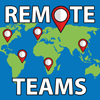 Remote teams communicate better when they pay attention to three things
Remote teams communicate better when they pay attention to three things
Jinfo Blog
19th March 2020
Abstract
A number of information teams, like much of the working world, may be facing up to the challenge of remote working as a team for the first time. Jinfo has a deep bank of knowledge and advice to call on, built up over years of work within its own operations and those of its customers. Here, we go through the three key things you need to get right.
Item
 Here we offer our tips to information teams who may be newly facing the challenge of communicating at a distance. For more resources on remote teams, check out our Focus page.
Here we offer our tips to information teams who may be newly facing the challenge of communicating at a distance. For more resources on remote teams, check out our Focus page.
Jinfo has worked on this challenge for years, both in our own operations and those of our customers.
Our research and business experience suggests that there are three variables that matter most in remote team and customer communication:
-
Consistency: Communicating based on norms, in expected and reliable ways
-
Presence: Compensating for physical absence with increased virtual presence
-
Tools: Using the right tool for the job.
Below, we summarise the changes you can make today that will ease the strain and improve morale and efficiency of your team and customers.
These are detailed in the Jinfo Report, "Maturity model on remote teams", which you can access directly if your organisation has a Jinfo Subscription.
1. Consistency
More important than what tools you use is the principle of consistency. We at Jinfo have seen just about every system used functionally in all ways you can imagine, but successful teams are consistent.
This means:
-
Agreeing on when and how you will use email, messaging, meetings, etc.
-
Creating conventions – and following them – for email subject lines, naming documents, etc. (Have you ever tried to find an email in your "sent" list with the subject line, "Urgent!" but no further information?)
-
Agreeing on response times for different types of communication - email is NOT a good tool if you want an immediate answer
-
Being accountable to each other regarding use of your internal rules.
Top tip for newly remote teams: Start the day with a 10-minute "set priorities for the day" team meeting; it will get your newly remote team in sync mentally and feel like they are "at work".
In a remote environment, consistency takes the place of non-verbal cues and behavioural norms that tell us all "we're at work, we're a team, we're operating".
2. Presence
When we eliminate physical proximity from the workplace, we need to replace it with proactive commitment to virtual presence.
At Jinfo, we have consistently created a team environment over many years through creative use of internal social channels (we use Slack) for:
-
General announcements everyone sees: "Hi, getting started"; "Going to lunch, back in an hour"; "Finished Project X - feeling good about it!"; "Closing up for the day - see you tomorrow".
-
Discussion amongst managers kept private to managers (a similar model could apply to project teams)
-
Water cooler chat: "I ran a 10k last weekend"; "My kid in his Halloween costume"; "My cat in his Halloween costume".
We can also use this environment for instant messaging between individuals when needed to answer quick questions. And our "consistency" rule is messaging when you need a response NOW, but otherwise use another communication channel and get a response within half a day.
In difficult times, the visible supportive presence of the team's manager, and of the team members for each other, is invaluable for maintaining team spirit and morale. Develop and use guidelines for being present to each other as colleagues and mutual supporters.
3. Tools
Remote teams need, at minimum, the following tools:
-
Email: for notifications, requests for input, status updates
-
Web-based meeting with video capabilities: for planned and ad hoc meetings, with an agenda; shared screen and use of video keeps everyone connected
-
Instant messaging: for quick questions and things needing a response now.
There are other tools we recommend, particularly project management systems, but these three are the essentials.
Email is ubiquitous, but if you do not currently have web-based meeting software or instant messaging, now is the time to investigate any of the many free (or free trial) tools out there. Just be sure to adhere to the tips above - create consistency and be present, or the tools won't help.
More support for remote work: communication is only part of it
We've focused here on communication, since that's the first line of defence against problems with remote working. For long-term, healthy and sustainable remote work, you also need to consider:
-
Project management and infrastructure
-
Information governance
-
Trust and transparency
-
Process optimisation
-
Team characteristics and development.
Jinfo addresses these components and more in our research and resources on optimising information team operations, with the aim of enabling you to deliver more value with reduced resources and effort.
We do this through:
- Blog items
- Subscription resources
- Consulting options.
Our Focus page on Remote Teams shows the full range of resources available.
Or use this curated list to get started:
1. Blog items on "Jinfo for optimising your information service":
-
Right tools for the job, December 2019
-
To manage capacity, know your objectives, September 2019
-
The human factor, June 2019
-
Building sustainable habits of optimisation, February 2019.
2. Subscription resources:
-
Article: Activating global teams - great tips from information managers in global organisations on communications, process, and the role of a manager
-
Article: Emerging technologies for centres of excellence - chatbots and digital adoption platforms - consider cost/benefit of new tools for customer relations
-
Report: Maturity model on the scalability of services - increase your team's resilience and capacity
-
Report: Jinfo model - recipe capture and optimisation - learn and practise principles of process documentation, to streamline and improve activity.
-
Webinar: Three elements of remote team success, 7th April 2020
-
Community: How to set the right norms for your team, 16th April 2020
-
Webinar: Operational components of a remote team, 21st April 2020
-
Webinar: Communication components of a remote team, 22nd April 2020
Jinfo Subscription starts at £2500 - learn more.
3. Consulting options:
-
Workshop: Future-proof your information service
Our Consulting workshops are web-based, private to you and tailored to your needs. Pricing starts at £3800; click a link to learn more and enquire. Or ask us about consulting work tailored to your specs.
- Blog post title: Remote teams communicate better when they pay attention to three things
- Link to this page
- View printable version
- Activating global teams
Monday, 2nd December 2019 - Emerging technology for centres of excellence: chatbots & digital adoption platforms
Friday, 22nd November 2019
- Jinfo model - recipe capture and optimisation
Monday, 7th October 2019 - Jinfo model - maturity model on the scalability of services
Tuesday, 4th June 2019
Vendor adoption of AI
Community session
23rd May 2024
AI prompting and AI-sourcing, US private companies, and Jinfo on YouTube
Blog posting
10th April 2024
April 2024 Update
YouTube video
10th April 2024
- AI prompting and AI-sourcing, US private companies, and Jinfo on YouTube
10th April 2024 - AI practical actions, prompting and outsourcing
6th March 2024 - GenAI and ESG wisdom of the Jinfo crowd
13th February 2024
- Jinfo Community session (TBC) (Community) 20th June 2024
- Vendor adoption of AI (Community) 23rd May 2024
- Offshore, outsource or AI-source? (Community) 16th April 2024

